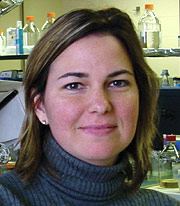Engineering viruses: using biology to assemble materials, devices
MIT Professor Angela Belcher of materials science and engineering and bioengineering has an army of specially trained workers who have built—molecule by molecule—a small, flexible rechargeable battery. Her tiny, nimble workers are viruses. Mixed with certain chemicals, they develop solid coatings and stack themselves into orderly layers, creating novel materials as well as minuscule wires, coatings, and electronic devices.
The best way to make ever smaller and more powerful electronic components is to build them molecule by molecule. However, manipulating materials at the “nano-scale” (a millionth of a millimeter) to get the structure and properties you want is tricky.
But Mother Nature knows how to do it. As a graduate student, Belcher worked with the abalone and came to admire its ability to build a sturdy shell. On its surface, the animal has proteins that bind to materials in seawater, producing neatly ordered nano-scale tiles of calcium carbonate that form a surprisingly strong shell.
Abalones evolved this special ability in response to materials in their ocean environment—calcium, some iron, a bit of silica. “But what if they weren’t confined to what was within their environment as they were evolving?” Belcher said. “What if they had the whole periodic table to work with?” An organism with different proteins on its surface might work the same magic with other elements, including ones of industrial interest.


